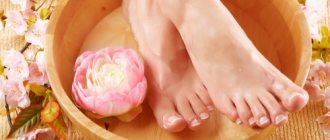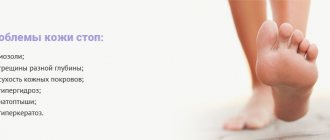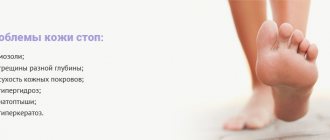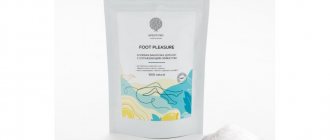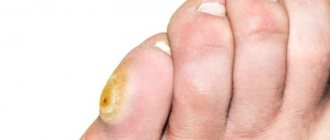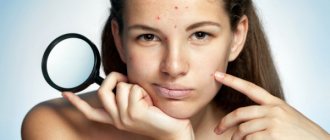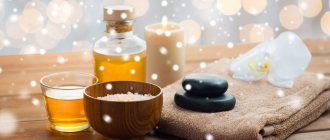When rough calluses appear on the toes, it is always unsightly and very painful. This problem is not uncommon; according to statistics, it periodically occurs in 80% of the adult population and 10% of children of different ages. Corns are usually treated at home, using proven pharmacy or folk remedies. If they do not go away for a long time, you should consult a doctor. Dermatologists and cosmetologists, and less often endocrinologists, deal with this problem.
Description of the problem and its classification
Corns on the toes are subcutaneous compactions that form when dead skin cells accumulate. Corns are a type of callus (hard callus).
- The corns with a rod have a convex yellow shape. In the center there is a black dot - a rod that penetrates deep into the layers of the epidermis. The main causes of formation are friction, compression, and viral infection. The last reason is extremely difficult to treat.
- A plantar corn looks like a callus, without the watery contents. When pressed, pain does not develop. The main reasons for this form are compression, friction, and excess moisture of the feet.
- Toe corns are calloused lumps that most commonly form on the big toe and under the toes. With significant growth, it is extremely difficult to cope with it.
How to recognize corns on the feet
The main symptom of corns is pain. A corn on the big toe is accompanied by enlargement of the toe and its deformation, which is accompanied by pain, which intensifies when wearing shoes. Corns between the toes are accompanied by pain, discomfort and a feeling of friction between them.
Regardless of location, corns rise slightly above the skin, have a yellow or whitish color with a dry or wet surface. Around the corns, as a rule, tissue swelling occurs, which is accompanied by redness of the skin area. There may be a slight increase in local temperatures.
Types of corns on feet and their photos
Symptoms
The main signs that a person may have or already have corns are:
- thickening of the skin;
- redness of the affected area;
- changes in the structure of the skin, the area becomes rougher;
- decreased sensitivity;
- the appearance of pain when walking;
- change in skin color, it becomes lighter, even yellowish.
Even before corns appear on the fingers, pathological changes in the skin in the form of swelling and slight redness can be detected.
It often happens that dry calluses appear suddenly, without symptoms. You can observe a thickening of the skin and a change in its structure, namely: it becomes rougher, without clear boundaries with a whitish or yellowish color.
Corns can be convex or flat in shape, with a rough or smooth surface. The patient may note that the skin of the affected area has become less sensitive to tactile and pain reactions.
In addition, when dry calluses appear, many people notice discomfort when walking due to the pressure of the body weight on the callus. Painful sensations may intensify during inflammation and infection, as well as when deeper cracks appear.
Causes of corns on the soles
Corns on the fingers, balls of the feet and under the toes are most common in women due to:
- long-term wearing of uncomfortable shoes: high heels, inappropriate in size, with thin soles;
- frequent walking without shoes (barefoot);
- low-quality materials used in the production of shoes - shoes made from artificial materials do not allow the skin to breathe. As a result, the feet sweat, which creates a favorable environment for the development of infection and causes strong friction between the foot and shoes.
Hidden causes of corns
Corns do not always occur as a result of wearing uncomfortable or low-quality shoes. Sometimes corns may appear against the background of:
- endocrine disorders (diabetes mellitus, thyroid disease);
- circulatory disorders in the legs (varicose veins);
- development of bacterial flora;
- excess body weight, which increases pressure on the foot;
- deformation of leg bones;
- stress, nervous tension.
Doctors also determined that depending on the location of the callus, their cause can be determined.
- If you have corns under your toes on your right foot , you most likely have liver problems.
- A lump on the left leg under the toes indicates diseases of the cardiovascular system.
- A corn on the big toe often indicates endocrine disorders.
If during the diagnosis the doctor identifies one of these problems, consultation with other specialists is required who will prescribe appropriate therapy.
The most effective drugs against worms
On pharmacy shelves you can find many wide-spectrum drugs designed to combat parasites. Some of them have repeatedly proven their effectiveness and are successfully used in medical practice. Let's consider the most popular means.
Dekaris and Nemozol
Both drugs are similar in their principle of action. They paralyze helminths, which prevents their reproduction in the human body. As a rule, they are taken in combination. First, the patient drinks Dekaris, which stops the activity of parasites, and Nemozol, which is drunk three days later, which helps destroy the parasites.
Pirantel
The drug acts directly on the nerve endings of helminths, and its main purpose is to combat ascariasis and enterobiasis. It is distinguished by its gentle action and is often prescribed for the treatment of children over six months of age. It is also used to treat helminths in pregnant women and new mothers, but in the latter case, consultation with a doctor is required, and breastfeeding will also need to be stopped.
Vermox
A “lighter” analogue of Nemozol, which will be most effective against enterobiasis and trichuriasis. Can be used from 2 years of age, but is strictly contraindicated for people with liver failure, Crohn's disease and other disorders of the body's excretory system. The main benefit is that 90% of the drug is eliminated from the body during urination and bowel movements. Safe for children and can be used by pregnant women, but only after consulting a doctor.
Albendazole
In addition to a wide spectrum of action, the drug is used to get rid of tissue parasites, echinococci, tapeworms, etc. The drug actively spreads throughout the body and penetrates directly into the bodies of helminths, destroying them from the inside. It is excreted from the body along with bile and a little in urine. Albendazole is contraindicated in pregnant women and people with impaired functioning of the kidneys, gallbladder and liver. During use, constant monitoring by a doctor is necessary, especially by a gastroenterologist.
Carbendacim (Medamin)
The drug is intended primarily to combat parasites that live in the intestines (roundworms). It affects the nervous system of parasites, which causes paralysis, after which they can no longer attach to the intestinal walls. The drug is not absorbed into the intestinal wall and acts exclusively on parasites.
Carbendacim is not used during pregnancy, is not prescribed to children under three years of age, or during breastfeeding. The dosage is calculated individually, taking into account the characteristics of the patient’s body.
How to get rid of corns
When the first signs of corns appear, the question arises whether it is possible to cope with them and how to do it.
There are two ways: professional removal and removal of corns at home. In the first and second treatment options, it is possible to cope with the compaction, but sometimes you need to be patient.
It is quite difficult to remove corns on your fingers at home. To do this, we recommend taking warm foot baths every day, treating the corns with a brush or pumice stone, and applying compresses with ointments or folk remedies.
We advise you to read: How to get rid of corns at home
Regardless of the location of the corns (on the thumb, between the fingers or under the fingers), they will help you remove them in a beauty salon using hardware or manual methods .
In the first case, the specialist will use a device with various attachments, with which he will remove the stratum corneum of the skin.
In the second case, to remove the corns, the specialist will treat the feet and soften the skin using baths, creams, ointments and remove the seal with a special tool.
We recommend that you consult a dermatologist before choosing one of the presented methods of dealing with corns. The doctor will conduct a study - take blood and scraping from the corn for analysis. The results will help determine the reasons for the appearance of compactions.
When is surgical treatment required?
Surgery to remove calluses is performed extremely rarely. As a rule, it is recommended for changes in the bone structure (for example, a hammertoe or an outward curvature of the big toe). Remember, it is difficult to treat the growth surgically. Left untreated calluses cause complications:
- Sharp pain while walking or putting on shoes, which limits or makes motor activity impossible.
- Changing your posture to reduce pain. Ultimately, it leads to curvature of the spine.
- Development of bursitis.
- The appearance of severe and massive blisters on the skin.
- Bone infection.
- Septic arthritis (joint infection).
- The appearance of massive ulcers on the skin.
Surgical removal
If the use of ointments, creams or a patch can achieve the desired result and the calluses cause pain and bleed, and the skin next to them is red, it is advisable to seek surgical removal. You need to see a podiatrist or plastic surgeon. Excision of the affected area with a scalpel involves cutting off the horny mass from the surfaces of the fingers. Before the operation, the patient is given painkillers.
A more complex technique is to drill out the corns along with the rod. During the procedure, specialists use antiseptics and softeners.
The treatment plan looks like this:
- Disinfection of the affected foot.
- Grinding away dead cells with a coarse abrasive instrument.
- Drilling out the root with a notched round bur.
- Place a softener into the formed cavity with further removal of dead particles.
- Drilling until the patient complains of a tingling sensation (this indicates that the drill has reached living tissue with nerve endings).
- Sanding and applying an adhesive plaster to the treated area.
More gentle methods for removing corns include aqua peeling, laser therapy, electrocoagulation, and cryodestruction.
Liquid nitrogen removal
The procedure involves removing corns using liquid nitrogen. You need to use the procedure if the corns are large, and they are either on the heels or the toe with the shaft.
The manipulation involves cauterization of the diseased area, leading to minor feelings of pain. There is a threat of damage around healthy areas and infection in the sole of the foot. Therefore, foot care must be thorough.
To cure your heel you need to:
- Spend a few days in bed.
- Avoid applying too much pressure.
- Take special baths.
- Use ointments that accelerate tissue healing.
Drilling
In the first case, treatment is carried out by a cosmetologist. In this case, a device with various drills is used. This method is suitable for calluses without a stem. The area of skin with it is treated twice with a bur of larger and then smaller diameter. There should be no blood. The procedure is usually painless. In advanced cases, a course of baths is carried out first.
Cryotherapy
Cryotherapy involves removing corns using liquid nitrogen. It is used when calluses are advanced or have a deep core. As part of cryotherapy, the affected area of the skin is treated with liquid nitrogen, which is odorless and colorless. After a few days, the seal in the form of a corn will disappear. This treatment method is painful and may cause discomfort. There is a risk of affecting healthy skin near the corn or causing an infection after treatment with liquid nitrogen, so you should be careful about caring for your feet after the procedure.
Laser removal
The use of a special device allows you to remove corns on the heels without pain and quickly. Using radio waves, dead epidermal cells are destroyed without affecting the area without damage.
The advantages of laser removal include:
- To get rid of affected areas on the heels, no preparation is required; manipulation can be carried out immediately after consulting a doctor.
- The duration of the process is up to 10 minutes.
- There is no pain as local anesthesia is used.
- A rapid improvement and return to normal life is recorded.
- The result is noticeable after one session; if required, several procedures are performed.
- There are no recurrences of corns in the heel area.
- At the end of the manipulation, you can immediately lean on the heel area and walk.
Surgical removal
If necessary, as well as your desire, corns can be removed in a medical facility using modern surgical methods:
- Drilling . This type of procedure is most often used in beauty salons, less often performed in a medical facility. Seals without a rod and small in size must be drilled. The procedure is painless. Before performing it, the specialist treats the foot with disinfectants, and, if necessary, takes thermal baths.
- Liquid nitrogen removal or cryotherapy . This procedure is used if the corns have a rod that penetrates deep into the skin or the corns are located between the toes. Using a syringe, nitrogen is injected under the skin. After a minute, it begins to work, peeling off the rod, which is easy to remove.
- Laser removal . The most popular, painless and fastest way to deal with seals. Used for core corns that occupy large areas of the foot. In addition, the advantage of this method is the removal of bacterial flora. Laser removal is not recommended for diabetes, open wounds, or oncology.
Preventive actions
To keep your foot skin clean and well-groomed in the future, you should follow a few simple rules:
- You only need to buy shoes of good quality and comfortable shape.
- You should not choose shoes with tapered toes for everyday wear.
- High heels in shoes are suitable for special events, but not for everyday ones.
- The best option for daily walks is shoes with a small wedge - you should not choose completely flat soles.
- Socks should be made of natural fabric.
- You should regularly properly care for the skin of your feet, using masks, special creams and baths.
If formations in the toe area appear frequently, it makes sense to think about the internal state of the body. You may need to visit an endocrinologist, neurologist or gastroenterologist.
Pharmaceutical products against corns
If your corns hurt, you can use pharmaceutical products that will help get rid of the seal, thanks to their softening effect, and relieve pain thanks to their mild analgesic and cooling effect.
Before choosing from a wide variety of ointments and creams, we recommend consulting a dermatologist. The most effective ointments are Super Antimozolin, Bensalitin, Salicylic ointment.
- The active components of Super Antimozolin ointment are lactic acid and urea, which, penetrating the skin, have a softening and loosening effect. After applying the ointment, the keratinized skin comes off easily, which helps to quickly deal with the problem.
- Bensalitin contains benzoic and salicylic acid, which soften dead skin cells. In addition, the ointment has an antiseptic effect.
- Salicylic ointment has a softening, wound-healing, anti-inflammatory effect. Is hypoallergenic.
To cope with corns using pharmaceutical products, follow these rules:
- Step 1. Steam your feet in a warm bath with salt, soda or soap.
- Step 2: Treat the calluses on your toes with a brush or pumice stone.
- Step 3. Prepare a plaster, cotton wool, bandage or cotton pad that can be used to secure the ointment to the problem area.
- Step 4. Treat the corn with ointment.
- Step 5. Place a piece of cotton wool, bandage or cotton pad on the ointment.
- Step 6. Secure the bandage with adhesive tape.
It is recommended to change this dressing daily until the core and the corns are completely removed. Today at the pharmacy you can buy ready-made anti-corns patches soaked in salicylic acid.
We advise you to read: Lump on the foot near the big toe
Review of popular brands
There are two types of Urgo patch: for removing growths and protective. The first helps to get rid of even old dry and core calluses. It contains wheat germ oil, which makes rough skin soft again. A distinctive feature of the patch is the foam padding. It protrudes above the surface of the sticker base and prevents the active ingredients from leaving the damaged area. This is very helpful: otherwise healthy skin would react with allergies and itching.
In the instructions, the manufacturer indicates that before using the patch, you should steam your washed feet for 10-20 minutes. Apply to dry skin and leave for 24 or 48 hours. If the callus is not removed during this time, then the procedure should be repeated every other day. The price of an adhesive plaster depends on its size: 150−300 rubles.
The manufacturer of the Compeed patch offers many varieties: from wet and dry growths, calluses between the fingers, corns. You can also choose the shape to suit your needs. It is almost invisible on the skin because the silicone tape is translucent.
For example, the “Compid” patch for corns is made using a special hydrocolloid technology. Silicone does not allow water to pass through, but allows the skin to breathe. A greenhouse effect is created under the sticker. In this humid environment, the active substance (salicylic acid) performs its tasks even better: softens the skin, exfoliates dead cells, moisturizes and has an anti-inflammatory effect. The silicone base of the patch reliably protects the foot from water, so you can swim with the Compeed patch.
In order for the adhesive plaster to “work”, the manufacturer indicates that the feet must be steamed in hot water (from 10 minutes) and blotted before use. After making sure that there are no wounds on the skin, you need to apply the patch so that it does not come into contact with healthy tissue. After 1-2 days the growth will turn pale and soften. After this, remove the callus with pumice. “Compid” even copes with old core calluses, but if it doesn’t work the first time, the cycle must be repeated.
Compeed also helps get rid of wet calluses using the same hydrocolloid technology. The skin is moistened so that the lid of the callus peels off on its own: forcefully opening the dropsy is painful and unsafe. This type of Compid patch, unlike the previous one, has a special moisture-absorbing layer. It will “take away” the liquid when the callus bursts on its own. The “Compid” patch for corns costs 230-450 rubles.
“Salipod” is a domestic adhesive plaster, so it’s inexpensive, but it removes dry calluses perfectly. Its effectiveness is explained by its medicinal composition. Salicylic acid softens, fights bacteria, relieves inflammation and thereby relieves pain. Sulfur acts on the rod, promoting its resorption. Lanolin helps sulfur and salicylic acid penetrate deeper and restores the skin. “Salipod” is produced in one piece, from which you need to cut out a sticker of the desired size and shape. The kit includes a regular adhesive plaster for fixation. The price is 65−100 rubles.
Cosmos patch. To get rid of wet and dry calluses, the same hydrocolloid technology is used. The instructions for different types of patches are different. The main thing is to attach the sticker so that the area with the medicinal composition covers the callus. “Cosmos” adheres perfectly to the skin without peeling off. It is invisible, so it can be worn even with open sandals. Cosmos costs a little more than 200 rubles.
Previously, in order to get rid of calluses and corns, it was necessary to act in two directions: at home use a cream or ointment for calluses, and “on the way out” you had to seal the callus that had not yet had time to heal in order to reduce the pain from rubbing shoes. Now, thanks to the anti-callus patch, protection while walking and treatment are one continuous process.
The base protects the damaged area, and if it is made of silicone, it does not even allow water to pass through. Plasters for corns on the feet have only one caveat: you must strictly follow the instructions.
How to treat corns on toes at home
If the size is small, there is no stem, and if the corns do not hurt, you can use traditional medicine recipes. We recommend that you consult a dermatologist before using them. In order to cure corns, it is necessary to carry out complex procedures, which include:
- foot preparation (foot baths and sole treatment);
- applying an emollient (homemade ointments and compresses).
Foot baths
- Bath with soap . To prepare, you will need 5 liters of warm water and 30 g of grated soap, soda and ammonia. Mix everything thoroughly. Take the bath for up to half an hour.
- Salt bath . Dilute 50 g of salt in 5 liters of warm water. We recommend using sea salt, which contains vitamins and minerals. If it is unavailable, use table salt. Take this foot bath for 30 minutes. You can also add a few drops of iodine or hydrogen peroxide to the bath.
- Serum bath . Whey is an excellent emollient that contains proteins, fats and carbohydrates of animal origin, vitamins A, C, E, group B and nicotinic acid. Such baths will not only help cope with corns, but will also soften the skin, moisturize and nourish it with useful substances. — To prepare a bath you will need from 2 to 5 liters. This volume is enough to cover your feet. Bring the serum to the optimal temperature and immerse your feet in it for 30 minutes.
- Bath with medicinal herbs . To prepare a bath, you can take one type of medicinal plant or several. Calendula, St. John's wort, and chamomile are excellent against corns. — For 5 liters of bath water you will need 500 ml of decoction. To prepare the decoction, pour 5 tbsp. l medicinal plant 0.5 l water and boil for 5 minutes. Pour the decoction into the bath water. Take a bath for 20-40 minutes.
- Bath with potassium permanganate . Add a little potassium permanganate and boric acid solution or powder to the warm bath water. Keep the feet in the water for 15 minutes.
- Rice baths . To prepare such an unusual bath, boil 300 g of rice in 5 liters of water. When the rice has cooled to an acceptable temperature, drain the broth and dip your feet in it. Keep the legs in the broth until it cools completely.
We advise you to read: How to prepare a foot bath for foot fungus
Compresses
After the bath, apply a medicinal compress to the steamed skin of the corn. We recommend applying compresses at night - this will prevent excessive mobility. Also secure the compresses with a bandage and put on socks on top.
- Lemon juice . Secure a lemon drop onto the problem area overnight with a bandage.
- Aloe . Cut the aloe leaf crosswise and place the fleshy side on the corns, secure with a bandage.
- Potato . Grate raw potatoes or chop them using a blender, apply to the corns and fix.
- Coltsfoot juice . Apply plant juice to problem areas throughout the day.
- Onion and garlic . Grind the vegetables using a grater or meat grinder. Apply the resulting mixture to the corns on your toes and secure with a bandage. Onions and garlic can be used together or separately.
- Vinegar . Soak gauze or a cotton pad with table vinegar and place it on the corns, secure with a plaster or bandage. When using vinegar, be careful to avoid contact with healthy skin. Acetic acid causes burns.
- Propolis . Grind a little propolis and apply it to the seal, secure with a plaster or bandage.
Removal using baths
Baths with the addition of certain components have long been used to remove dry calluses. With their help, you can soften the keratinized area of the skin, mechanically remove the growth and prevent its reappearance in the future. Such procedures have practically no contraindications, with the exception of the presence of varicose veins and other vascular diseases, for which it is forbidden to steam the legs. Such baths should not be given to pregnant women, as this can lead to premature birth. In all other cases, such a procedure will help a person clean the surface of the tissue from unpleasant formations, returning it to a beautiful and well-groomed appearance.
Baths with the following ingredients help with corns:
- saline or soda solution, adding a couple of drops of iodine;
- lemon juice mixed with a small amount of starch and sea salt;
- apple cider vinegar;
- decoction of oats or flaxseed;
- wheat and oat bran;
- undiluted juice of sour apples.
The procedure should be done every day when formations appear and several times a week to prevent their occurrence. The water for bathing should be hot enough, but acceptable so that it is comfortable to keep your feet in it for 10-15 minutes.
According to the season, when medicinal herbs begin to actively grow (May - August), you can make baths with the addition of decoctions from them. Chamomile, sage, calendula, string, celandine, lovage, burdock and dandelion root help well in this regard. They need to be mixed in arbitrary proportions, boiled for 10 minutes, allowed to cool slightly and then used for baths.
During the procedure, the active components of herbs penetrate into tissue cells, providing antiseptic, antibacterial, wound healing and regenerating effects. In addition, they saturate cells with nutrients and strengthen local immunity. As a result, the build-up is eliminated, and the skin looks clean, soft and smooth, without cracks or redness.
Prevention
To avoid the formation of corns and not to think about how to get rid of them, we advise you to adhere to the following rules:
- Wear comfortable shoes. It should be soft, moderately loose, with low heels.
- It is advisable to buy shoes made from natural materials. This will help prevent your feet from rubbing against your shoes. Also, wearing natural boots or shoes, the skin of your feet will breathe and not sweat.
- Take good care of your foot hygiene. Do not put on shoes if your feet are wet or dirty. Trim your nails. We advise you to read: Foot care at home - how to properly care
- Do not wear shoes without socks or stockings. Wearing them will help get rid of skin chafing and the formation of corns.
- Monitor the condition of your skin - make softening baths, masks, promptly cleanse the skin of dead cells with a brush or pumice stone. We advise you to read: Foot bath with soda: recipes and recommendations
- For scratches, cracks, bleeding, treat the affected areas with disinfectants, wound healing, and emollients.
- If there are deformation changes in the foot (flat feet), consult an orthopedist who will recommend special exercises and select orthopedic insoles in accordance with the characteristics of your foot.
- Don't go barefoot in public, don't use other people's foot care products, and don't wear other people's shoes.
Did you like the article? Share with friends:
